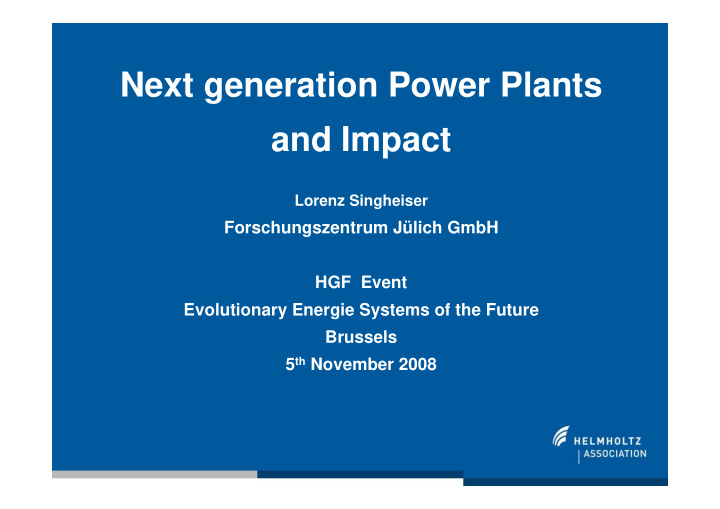



Next generation Power Plants and Impact Lorenz Singheiser Forschungszentrum Jülich GmbH HGF Event Evolutionary Energie Systems of the Future Brussels 5 th November 2008 PAGE 1
Global electricity generation TWh TWh 40000 40000 35000 35000 Erneuerbare o.W. renewables without water Wasser water 30000 30000 Nuklear nuclear Gas gas 25000 25000 Öl oil Kohle coal 20000 20000 15000 15000 10000 10000 5000 5000 0 0 1990 2004 2015 2030 1990 2004 2015 2030 Quelle: IEA 2006 source: IEA 2006 reference scenario World Energy Outlook 2006, IEA Gas 2004 Gas 2004 – 2030: + 128%, Coal 2004 – 2030: + 128%, Coal 2004 – 2030: + 112% – 2030: + 112% Long-term energy mix with CO 2 - emissions
Long-term goals of Cooretec – Strategy http://www.fz-juelich.de/ptj/projekte/datapool/page/1329/doku527.pdf
CO 2 reduction by increased efficiency of combined cycle Power plants 40 GT 26 35 2 - Reduction (%) aero engine technology 30 GT 13E1 GT 13E2 25 GT 13D2 20 Source : Alstom 15 GT 13D 10 CO Basis: Turbine with 880 °C, 9,6 bar 5 GT 13B GT 13C 0 1970 1980 1990 2000 Year of introduction Efficiency increase: less emissions & fuel savings
Materials Research for Gas Turbines at Helmholtz - reliable thermal barrier coatings (TBCs) for combustors and front stage blading - new TBCs with higher temperature capability 1400 °C - life prediction methodologies for TBC coated SX alloys as integral part of the design - austenitic rotors (also for steam turbines) - fibre reinforced ceramics and intermetallics Source: Siemens Journals Gas temperature target: > 1400 °C to ensure efficiencies Base material life: 50000 h > 65 % (2015) Coating life: 25000 h > 70 % (beyond 2020) Rotor life: 100000 h
New TBC Systems for > 65 % Efficiency offer highest potential for GTs > 1400 °C La 2 Zr 2 O 7 1100 °C 1100 °C YSZ YSZ > 1000 °C 950 °C MCrAlY bond coating new bond coatings current DS, SX alloys next gen. SX alloy 200 µm Temperature state of the art TBC system goal 2015 TBC system Vaßen, et al. Institute of Energy Research IEF 2 Mi t t d P ti f M t i l
High efficient coal fired power plants state of the art: 1000 MWel, 610 °C / 275 bar, η = 45 % 2014: 700 °C, 350 bar, η > 50 % 2020: 760 °C, 350 bar, η = 55 %)
Coal fired power plants and new processes > 700 °C Steam power plants: P92, 600 °C, steam 700 °C, steam • Ni alloys with higher creep strength • steam and fireside corrosion resistance • low cost manufacturing and welding • microstructural stability & life modeling IN 617, 700°C, steam IN 617 pipe at 700 °C New power plant processes Gas Oxyfuel, IGCC Gasifier Cleaner • environmental & mechanical integrity • chemical hot gas cleaning of fossil and biogenic fuels • deposit formation 8
Efficiency increase not enough to meet CO 2 reduction targets of EU efficiency increase by 5 %-points: 10,2 % CO 2 - reduction efficiency increase by 10 %-points: 20.5 % CO 2 - reduction Carbon capture and storage technologies required : >80 % CO 2 - reduction Current capture technologies (air liquification, MEA wash) result in efficiency penalties of 8 – 15 % : 30 % MORE FUEL REQUIRED Capture by membranes offers less efficiency penalties : • FZ Jülich: ceramic membrane systems • GKKS Geesthacht : polymer membrane systems • GFZ Potsdam: storage of CO 2 :
Gas separation membranes in power plants fuel (fossil, biomass) CO 2 Post air N 2 /CO 2 (90%N 2 /10%CO 2 ) combustion Power plant separation N 2 fuel (fossil, biomass) O 2 air N 2 /O 2 Oxyfuel condensation CO 2 Power plant separation CO 2 +H 2 O N 2 Power plant fuel Pre (N 2 ), H 2 O H 2 O (fossil, biomass) combustion H 2 CO 2 H 2 ,CO 2 O 2 air partial H 2 /CO 2 CO N 2 /O 2 condensation oxidation separation (N 2 ) shift separation CO 2 + H 2 O N 2
HGF-ALLIANCE MEM-BRAIN Gas Separation Membranes for Power Plants Strategy: • strategic alliance HGF & Univ. • bundling of competences Überblick zur Helmholtz Allianz MEM-BRAIN • create critical mass Topics: • new materials with • high permeability • long-term stability • manufacturing technologies for components • process analysis • economic and ecological aspects
Development of components, testing & life models Powder proceesing & manufacturing components & upscaling 150 LSCV pO 2 = 10 -20 bar pO 2 = 10 -15 bar stress [MPa] 100 air 50 0 0 0,05 0,1 0,15 0,2 strain [%] permeability & selectivity mechanical integrity & environmental stability
Process analysis Integration of membranes into power plants • identify optimum operation conditions • temperature, pressure, gas composition • minimize efficiency losses • cost calculation • benchmark with competing capture technologies • design & integration of membrane modules CO 2 and H 2 O Kneer et al.
Roadmap: Membrane based CO2 capture CO 2 -free Technologies Vattenfall Oxyfuel, 30 MW E.ON CC Oxyfuel, UK CO 2 –free power plants ADECOS RWE- IGCC, 450 MW CCS Technology OXYCOAL- AC, 500 KW Component tests Membrane Research MEM-BRAIN I MEM- BRAIN MEM-BRAIN II MEM-BRAIN III Component development Upscaling & Testing Basic Research Basic research Component development Upscaling & testing Membrane Institute Centre for CO 2 -free Energie Conversion η− Technologies 700 °C steam PP, > 500 MW CC Irsching Siemens, η > 60 % EON, η > 50 % 2010 2015 2020
THANK YOU ! L. Singheiser PAGE 15
Recommend
More recommend